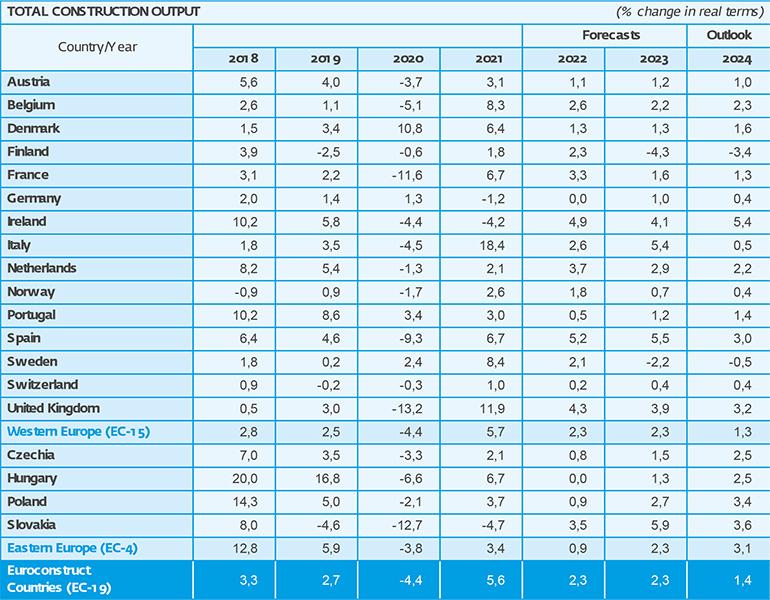The European construction market to 2024
Construction volume in the Euroconstruct area will grow by 2.3% in 2022, with a similar rate forecast for 2023.
Following a decline in output in 2020 (-4.4%), the construction industry in the 19 Euroconstruct countries staged a recovery in 2021 with a 5.6% increase in construction output to €1.856 billion, largely closing the gap with respect to 2019.
Out of the 15 Western countries (EC-15), ten reported a higher total construction volume in 2021 than in the pre-pandemic year 2019. Of the BIG-5 countries, only Italy significantly surpassed its pre-crisis level in 2021 (+13.0%, after a decline of 4.5% in 2020). In Germany, construction output in 2021 was close to the level of 2019 (+0.1%), while production was 5.7% lower in France, 3.2% lower in Spain and 2.9% lower in the United Kingdom. All Nordic countries achieved a higher total construction volume in 2021 compared to the pre-pandemic year 2019, with Denmark showing the highest growth (+17.8%).
Out of the four Central and Eastern European countries (EC-4), only Poland achieved a higher total construction volume in 2021 compared to 2019 (+1.5%), while the construction industry in Slovakia experienced a deep recession with a decline of 16.8%.
According to forecasts, total construction growth in the 19 Euroconstruct countries will slow to 2.3% in 2022, with a similar rate forecast for 2023. This is due to market instability exacerbated by the war in Ukraine and the high levels of inflation, which are dampening economies’ propensity to invest in new construction projects.
The data were released during the 93rd Euroconstruct Conference held in Warsaw on 9 and 10 June 2022, which also provided forecasts for the European construction market to 2024.
Outlook 2022-2024: countries and market segments
A cumulative increase in construction output is predicted in the Euroconstruct area over the forecast period 2022-2024. In the EC-15 countries, cumulative growth will amount to 6.1%, which is slightly lower than for the EC-4 countries where a rate of 6.4% is forecast. The strongest cumulative growth is expected in Ireland (+15.1%), followed by Spain (+14.3%) and Slovakia (+13.5%). Stagnant tendencies are forecast in the largest European construction markets. Germany’s output declined in 2021 (-1.2%) after minor expansion in 2020 (+1.3%) and an increase of less than 1.5% is expected for the whole period 2022-2024. The expectations for the Scandinavian countries vary. The outlook for Finland and Sweden is considerably more negative, while Norway and Denmark are expected to see a total increase of 3-4% over the forecasting period.
All three main market segments (building construction, civil engineering and renovation) will see rather moderate growth with expected annual growth rates of between 2% and 3% due to the continued high level of economic uncertainty. The continuation of the war in Ukraine and the possible resurgence of the pandemic in autumn increase the uncertainty about the future and may lead to a recession in the construction industry in some countries. In this scenario, the current projections made by Euroconstruct forecast a significant slowdown in the growth rate of residential construction to 1.3% in 2024. This is the combined result of stagnation trends in both new residential construction and renovation (1.5% and 1.2%, respectively).
Following the sharp decline in total non-residential construction in 2020, production is forecast to recover in 2022-2024. However, non-residential construction is not expected to return to pre-pandemic levels in several EC-15 countries (France, Germany, the UK, Finland and Ireland) or in two EC-4 countries (Slovakia and the Czech Republic).
Civil engineering, the segment that was least affected by the pandemic (output decreased by just 0.4% in 2020) due to the implementation of numerous large infrastructure projects, is expected to grow by 2.7% per annum on average between 2022 and 2024. After accelerating to 3.9% in 2023, the annual growth rate will drop significantly to 1.7% in 2024.

Did you find this article useful?
Join the CWW community to receive the most important news from the global ceramic industry every two weeks






















